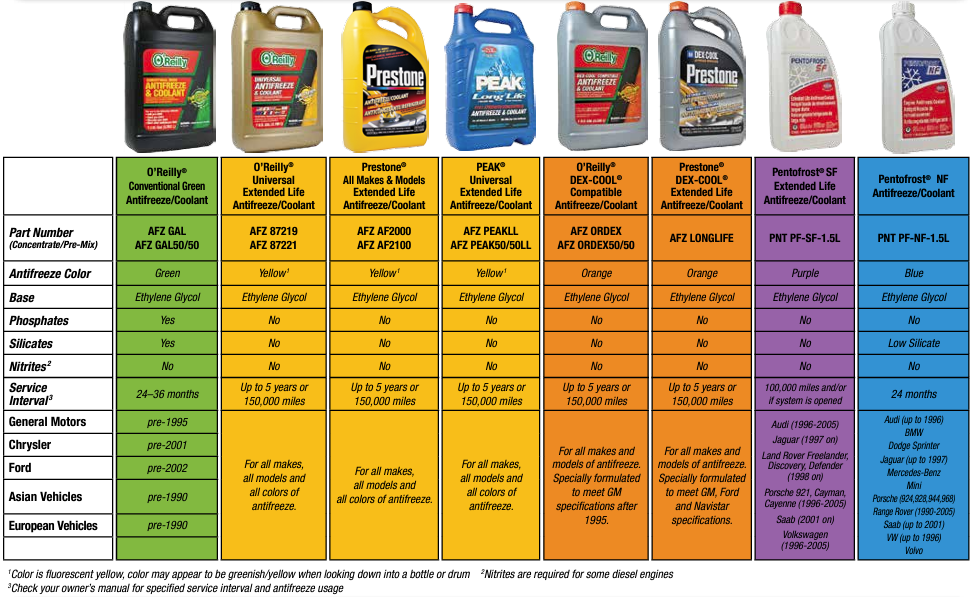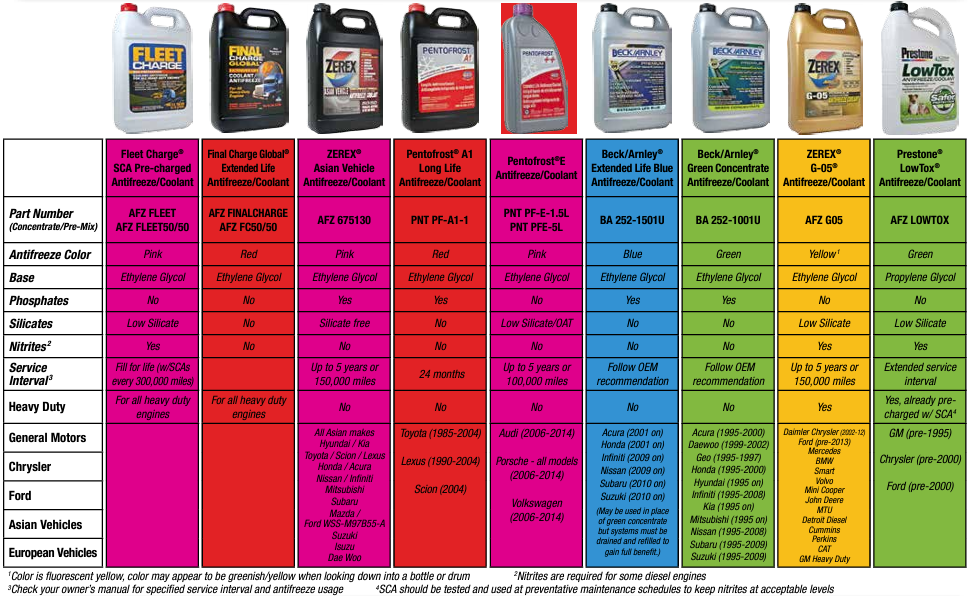Automotive Antifreeze/Coolant: A Comprehensive Guide
1. Traditional Green Antifreeze:
- Composition: Contains ethylene glycol and corrosion inhibitors.
Traditional green antifreeze is typically based on ethylene glycol, a colorless and odorless liquid that serves as the primary coolant agent. Ethylene glycol has exceptional heat transfer properties, making it adept at absorbing and dissipating the intense heat generated by the engine during combustion.
Complementing ethylene glycol are various corrosion inhibitors. These additives play a crucial role in preventing the formation of rust and corrosion within the engine's cooling system, particularly in components like the radiator and water pump. This protective aspect is vital to the longevity and optimal functioning of the engine.
- Color:Color: Typically green.
The green color of this antifreeze is not arbitrary; it acts as a visual cue. In the event of a coolant leak or when inspecting the coolant level, the distinctive green color makes it easy for mechanics and vehicle owners to identify the type of coolant in use. This aids in maintenance and ensures that the correct coolant is added when needed.
- Applications: Widely used in older vehicles. Not suitable for modern engines with aluminum components.
Traditional green antifreeze has been a standard choice for older vehicles, particularly those with cast-iron engines. However, its usage is not recommended for modern engines with aluminum components. The chemical composition of traditional green antifreeze may lead to corrosion in aluminum parts over time, highlighting the importance of using the right coolant for the specific engine materials.
2. Extended-Life Antifreeze (Orange/Yellow):
Extended-Life Antifreeze (Orange/Yellow), often known for its vibrant hue, is a cutting-edge coolant engineered to withstand the rigors of modern engine technology. What sets this coolant apart is its adoption of advanced technologies such as Organic Acid Technology (OAT) or Hybrid Organic Acid Technology (HOAT). This innovation contributes to a longer service life compared to traditional green antifreeze.
- Composition:
At the heart of Extended-Life Antifreeze is its unique chemical composition, which typically incorporates organic acids. These organic acids serve a dual purpose - preventing corrosion and minimizing cavitation. Corrosion inhibitors shield the various metal components in the engine from the harmful effects of rust and scale, ensuring the longevity and optimal functioning of the cooling system.
Moreover, the adoption of OAT or HOAT brings an extra layer of protection. OAT antifreeze includes organic acids that provide a durable shield against corrosion, especially for aluminum components found in many modern engines. On the other hand, HOAT antifreeze combines the benefits of OAT and traditional antifreeze, striking a delicate balance that suits a wide range of vehicles.
Extended-Life Antifreeze offers several advantages, making it a preferred choice for many vehicles:
- Extended Service Life: The name says it all. This antifreeze typically requires less frequent replacement, reducing maintenance efforts.
- Versatility: Engineered for compatibility with a variety of metals, including aluminum and cast iron, making it suitable for a broad spectrum of modern vehicles.
- Corrosion Protection: The organic acids form a protective layer, preventing the formation of rust and scale, thus extending the life of the engine components.
- Heat Transfer Efficiency: The antifreeze maintains efficient heat transfer, crucial for preventing engine overheating.
- Color: Typically orange or yellow.
- Service Life: Longer service intervals compared to traditional green antifreeze.
- Applications: Suitable for modern vehicles with aluminum components.
3. Hybrid Organic Acid Technology (HOAT) Antifreeze (Yellow/Gold):
In the realm of automotive antifreeze, Hybrid Organic Acid Technology (HOAT) stands out as a beacon of innovation. Often distinguished by its distinctive yellow or gold hue, HOAT antifreeze is a versatile solution designed for the demands of modern engines.
- Composition:
At the heart of HOAT antifreeze lies a carefully crafted chemical composition that sets it apart from traditional formulations. Unlike conventional green antifreeze, HOAT incorporates both Organic Acid Technology (OAT) and Inorganic Additives, striking a delicate balance for enhanced performance.
OAT Components:
- Organic Acids: These organic compounds, such as sebacic acid and 2-ethylhexanoic acid, serve as the primary corrosion inhibitors. They form a protective layer on metal surfaces, safeguarding the engine against corrosion and erosion.
- Additives: Nitrites and silicates, commonly found in OAT-based antifreeze, further fortify the protection against corrosion. Nitrites are particularly effective in safeguarding aluminum components, prevalent in modern engine designs.
- Inorganic Additives:
- Phosphates: While HOAT antifreeze may be phosphate-free in some formulations, others include a balanced amount of phosphates. Phosphates contribute to overall corrosion inhibition and prevent the formation of scale in the cooling system.
- Color: Yellow or gold.
- Advantages:
- Extended Service Life: The hybrid formulation of HOAT contributes to an extended service life compared to traditional green antifreeze. This translates to fewer maintenance intervals and long-term cost savings.
- Versatility: HOAT antifreeze is compatible with a wide range of vehicle models, making it a go-to choice for various automotive manufacturers. Its versatility stems from the combination of OAT and inorganic additives, providing protection for different engine types.
- Aluminum Compatibility: In the era of lightweight, fuel-efficient vehicles, where aluminum plays a significant role in engine construction, HOAT antifreeze's compatibility with aluminum is a critical advantage. It ensures optimal protection for essential components.
- Applications: Commonly used in a variety of vehicles.
4. Dex-Cool Antifreeze (Orange):
- Composition:
At the heart of Dex-Cool's prowess lies its carefully crafted chemical makeup. Unlike conventional antifreeze, Dex-Cool embraces organic acid technology (OAT), a cutting-edge formulation that revolutionizes the way engines maintain optimal temperatures.
Dex-Cool primarily consists of ethylene glycol, a tried-and-true coolant base that ensures effective heat transfer within the engine. However, what sets Dex-Cool apart is the incorporation of organic acids, which serve as corrosion inhibitors. These inhibitors form a protective layer on engine components, preventing the formation of rust and corrosion, particularly in the critical radiator and cooling system.
Moreover, Dex-Cool's orange color serves a dual purpose. It not only distinguishes it from other antifreeze types but also acts as a visual aid for easy identification. This can be particularly crucial in vehicles, ensuring the right antifreeze is utilized, thus preventing compatibility issues.
- Advantages:
- Extended Service Life: Dex-Cool is renowned for its extended service intervals. While traditional green antifreeze may require more frequent changes, Dex-Cool offers prolonged protection, reducing the frequency of maintenance.
- Aluminum Component Compatibility: In the era of lightweight and efficient engines with aluminum components, Dex-Cool emerges as a reliable ally. Its formulation is tailored to prevent corrosion in aluminum, ensuring the longevity of these crucial engine parts.
- Reduced Silicate and Phosphate Content: Dex-Cool's composition deliberately minimizes silicate and phosphate content, mitigating the risk of silicate gel formation and deposits within the cooling system.
- Compatibility Caution: However, a note of caution accompanies Dex-Cool. Mixing it with other types of antifreeze can compromise its efficacy and potentially lead to engine issues. Therefore, adherence to manufacturer recommendations is paramount.
- Color: Orange.
- Applications: Commonly found in General Motors (GM) vehicles.
- Caution: Should not be mixed with other types of antifreeze.
5. Phosphate-Free Antifreeze:
Phosphate-free antifreeze is a type of coolant that, as the name suggests, is free from phosphates. Phosphates are additives that are commonly used in traditional antifreeze formulations. The absence of phosphates in this type of antifreeze brings several advantages.
Chemical Composition: Phosphate-free antifreeze typically utilizes organic acid technology (OAT) or hybrid organic acid technology (HOAT). These technologies provide effective corrosion protection for the engine and cooling system components. The composition often includes ethylene glycol as the base fluid, which is a common coolant in automotive applications.
The key benefits of phosphate-free antifreeze include:
- Reduced Deposits: Phosphates can contribute to the formation of deposits in the cooling system. Phosphate-free formulations reduce the risk of deposit buildup, ensuring optimal performance.
- Corrosion Protection: The organic acids in the antifreeze create a protective barrier against corrosion, extending the life of the cooling system.
- Compatibility: Phosphate-free antifreeze is often compatible with a wide range of materials used in modern engines, including aluminum and other alloys.
It's important to note that while phosphate-free antifreeze offers many advantages, it's crucial to follow the manufacturer's recommendations for your specific vehicle. Always check the owner's manual or consult with a professional mechanic to ensure compatibility.
- Advantages: Reduces the risk of deposits and scale in the cooling system.
- Applications: Used in vehicles where phosphates could be detrimental.
6. Silicate-Free Antifreeze:
- Composition:
Silicate-Free Antifreeze is a specialized coolant designed for certain automotive applications. Unlike traditional antifreeze formulations, silicate-free variants exclude silicates from their chemical composition.
Silicate-Free Antifreeze typically uses organic acid technology (OAT) or hybrid organic acid technology (HOAT) as its primary chemical base. OAT antifreeze relies on organic acids, such as 2-EHA (2-ethylhexanoic acid), for corrosion inhibition. HOAT antifreeze combines the benefits of both OAT and traditional antifreeze, offering extended protection against rust and corrosion.
The absence of silicates in silicate-free antifreeze is advantageous in preventing silicate gel formation in the cooling system. Silicate gels can lead to radiator and water pump damage, reducing the efficiency of the vehicle's cooling system over time.
- Applications:
Silicate-Free Antifreeze is commonly used in Asian and European vehicles. Many modern engines, especially those with aluminum components, benefit from the corrosion protection provided by silicate-free formulations. It is essential to consult the vehicle manufacturer's recommendations and specifications to ensure compatibility.
When using silicate-free antifreeze, it's crucial to follow proper maintenance practices, including regular checks of coolant levels and adherence to recommended replacement intervals. Periodic flushing and changing of the antifreeze help maintain its effectiveness and protect the vehicle's cooling system.
By opting for silicate-free antifreeze, vehicle owners contribute to the longevity and optimal performance of their engines while minimizing the risks associated with silicate gel formation.
- Advantages: Reduces the risk of silicate gel formation in the cooling system.
7. Nitrite-Free Antifreeze:
Nitrite-free antifreeze is a specialized coolant designed for heavy-duty diesel engines. Unlike traditional formulations, this type of antifreeze excludes nitrites from its chemical composition, offering several advantages in engine protection and maintenance.
- Composition:
Nitrite-free antifreeze typically consists of a base coolant, usually ethylene glycol or propylene glycol, and advanced organic acid additives. These organic acid inhibitors provide superior protection against corrosion and cavitation, especially in the harsh conditions experienced by heavy-duty diesel engines.
By eliminating nitrites from the formula, this antifreeze reduces the risk of nitrite-related issues such as silicate gel formation. Silicate gel can contribute to engine problems, including radiator and water pump damage. The absence of nitrites also addresses concerns related to the formation of scale, ensuring optimal engine performance and longevity.
- Advantages of Nitrite-Free Antifreeze:
1. Cavitation Protection: Nitrite-free antifreeze effectively guards against cavitation, a phenomenon where bubbles form and collapse, causing damage to engine components over time.
2. Extended Engine Life: The advanced organic acid inhibitors contribute to a longer service life for the coolant, reducing the frequency of coolant changes and associated maintenance costs.
3. Compatibility: Nitrite-free formulations are often compatible with a wide range of heavy-duty diesel engines, making them a versatile choice for various applications.
For heavy-duty vehicles operating in demanding conditions, choosing nitrite-free antifreeze is a prudent decision. It not only safeguards the engine from corrosion and cavitation but also contributes to an overall increase in engine efficiency and durability.
Important Considerations:
Compatibility: It's crucial to use the antifreeze type recommended by the vehicle manufacturer.
Mixing Antifreeze: Mixing different types of antifreeze can lead to reduced effectiveness and potential engine damage. Always follow the manufacturer's recommendations.
Flush and Change: Periodically flushing and changing the antifreeze is essential to maintain its effectiveness and prevent corrosion.


|


